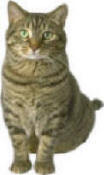What
is spraying?
Spraying
is the deposition of small amounts
of urine on vertical surfaces.
The spraying cat may be seen
to back into the area, the tail
may quiver, and with little
or no crouching the urine is
released. Although much less
common, some cats will also
mark their territory by leaving
small amounts of urine or occasionally
stool on horizontal surfaces.
Why
do cats "mark" with
urine?
Cats
mark the locations where they
live or where they frequent
in many ways. Cats will mark
with scent glands on their feet,
cheeks, face and tail as well
as with urine. Cheek rubbing
(bunting) and scratching (with
both the odor from the glands
in the footpads and the visual
mark) are both forms of marking.
Deposition of an odor communicates
that the  animal
was in a location long after
that animal has gone. Cats will
mark their territory to signal
"ownership" and
to advertise sexual receptivity
and availability. Marking can
occur due to other cats in the
vicinity either outdoors, or
among cats that live in the
same household. Cats will also
mark their territory when they
feel threatened or stressed.
This can occur with a change
in household routine, compositions,
living arrangements, new living
locations and other environmental
and social changes. In these
cases the marking pattern may
be related to new objects brought
into the household, or the possessions
of family members, especially
those with which there is the
greatest source of conflict
or insecurity. Because marking
is a method of delineating territory,
urine is often found in prominent
locations, at entry and exit
points to the outdoors such
as doors and windows and around
the periphery. When outdoors,
cats might tend to mark around
the periphery of their property,
prominent objects on the property,
new objects (e.g. a new tree)
introduced into the property,
and locations where other cats
have marked. animal
was in a location long after
that animal has gone. Cats will
mark their territory to signal
"ownership" and
to advertise sexual receptivity
and availability. Marking can
occur due to other cats in the
vicinity either outdoors, or
among cats that live in the
same household. Cats will also
mark their territory when they
feel threatened or stressed.
This can occur with a change
in household routine, compositions,
living arrangements, new living
locations and other environmental
and social changes. In these
cases the marking pattern may
be related to new objects brought
into the household, or the possessions
of family members, especially
those with which there is the
greatest source of conflict
or insecurity. Because marking
is a method of delineating territory,
urine is often found in prominent
locations, at entry and exit
points to the outdoors such
as doors and windows and around
the periphery. When outdoors,
cats might tend to mark around
the periphery of their property,
prominent objects on the property,
new objects (e.g. a new tree)
introduced into the property,
and locations where other cats
have marked.
Which
cats are more likely to urine
mark?
Both
male and female cats can mark
with urine. Urine marking is
most common in intact (non-neutered)
male cats. When an intact male
sprays urine, it will have the
characteristic "tom cat"
odor that is strong and pungent.
Neutering will change the odor,
and may reduce the cat's
motivation for spraying, but
approximately 10% of neutered
males and 5% of spayed females
will continue to spray. While
cats in multiple cat households
are often involved in spraying
behaviors, cats that are housed
singly may spray as well.
Instead
of spraying, I am finding multiple
locations of small amounts of
urine. What does that mean?
Some
cats will mark their territory
with small amounts of urine
(and on rare occasions, stool)
in various locations. These
locations can be similar to
those for spraying, i.e. near
doors, windows, new possessions
in the home or favored locations,
but may occasionally be found
on owner's clothing or
other favored possessions. However,
small amounts of urine deposited
outside of the litterbox is
more commonly due to litter
box avoidance which could have
many causes including diseases
of the lower urinary tract.
Similarly stool found outside
of the litter box can be due
to a multitude of causes including
colitis, constipation and any
other condition leading to difficult,
more frequent or uncomfortable
elimination. As with any other
elimination problem, a complete
physical examination and laboratory
tests are necessary to rule
out each physical cause.
How
do I treat a spraying or marking
problem?
 As
with all behavior problems,
the history will help determine
treatment options. The location
of the urine marking, the frequency,
duration and number of locations
are important. The number of
cats both inside and contacts
outside of the home should be
determined. Changes in environment,
social patterns of humans and
animals, and additions (people,
pets, furniture, renovations)
to the home should also be examined. As
with all behavior problems,
the history will help determine
treatment options. The location
of the urine marking, the frequency,
duration and number of locations
are important. The number of
cats both inside and contacts
outside of the home should be
determined. Changes in environment,
social patterns of humans and
animals, and additions (people,
pets, furniture, renovations)
to the home should also be examined.
If
the cat is not already neutered,
and is not a potential breeder,
castration is recommended. A
urinalysis should be performed
to rule out medical problems.
The location of the urine spots
should be determined. Is the
urine found on walls, 6-8 inches
up from the floor, or are there
small urine spots found in multiple
locations?
Treatment
is aimed at decreasing the motivation
for spraying. It has been shown
that spraying may be reduced
in some cases by reviewing and
improving litterbox hygiene.
Ideally the minimum number of
litter boxes should equal the
number of cats plus one, the
litter should be cleaned daily
and changed at least once a
week, and proper odor neutralizing
products should be used on any
sprayed sites. In addition any
factors that might be causing
the cat to avoid the use of
its litter should be considered
(see our handout on ‘House-soiling
in cats' for more details).
If
marking appears to be stimulated
by cats outside of the home,
then the best options are to
find a way to deter the cats
from coming onto the property
or prevent the indoor cat from
seeing, smelling or hearing
these cats. See our handout
‘Controlling undesirable
behavior in cats' and
our handout on ‘Behavior
management products' for
remote control devices and booby
traps that can be used to deter
outdoor cats and to keep indoor
cats away from the areas where
they are tempted to mark. It
may be helpful to house your
cat in a room away from windows
and doors to the outdoors, or
it may be possible to block
visual access to windows. When
you are home and supervising
you can allow your cat limited
access to these areas. It also
may be necessary to keep windows
closed to prevent the inside
cat from smelling the cats outside,
and to use odor neutralizers
(see our handout on ‘Behavior
management products')
on any areas where the outdoor
cats have eliminated or sprayed.
If
the problem is due to social
interactions inside the home,
it may be necessary to determine
which cats do not get along.
Keep these cats in separate
parts of the home with their
own litter and sleeping areas.
Reintroduction of the cats may
be possible when they are properly
supervised. Allowing the cats
together for positive experiences
such as feeding, treats and
play sessions, helps them to
get used to the presence of
each other, at least on a limited
basis. However, when numbers
of cats in a home reach 7-10
cats you will often have spraying
and marking.
I've
cleaned up the spot but the
cat keeps returning to spray.
What else can be done to reduce
the problem?
Since
the "purpose" of
spraying is to mark an area
with urine odor, it is not surprising
that as the odor is cleaned
up, the cat wants to refresh
the area with more urine. Cleaning
alone does little to reduce
spraying. Cats that mark in
one or two particular areas
may cease if the function of
the area is changed. It is unlikely
that cats will spray in their
feeding, sleeping or scratching
areas. It has also been shown
that cats that mark an area
with cheek glands are less likely
to mark in other ways such as
with urine. In fact it might
be said that cats that use their
cheek glands are marking in
a more calm, familiar manner
while those that urine mark
are doing so in a more reactive,
anxious manner. A commercial
product containing synthetic
cheek gland scent has proven
to be an effective way of reducing
urine marking in some cats.
When sprayed on areas where
cats have sprayed urine or on
those areas where it can be
anticipated that the cat is
likely to spray, it may decrease
the likelihood of additional
spraying in those areas. The
scent of the pheromone may stimulate
cheek gland marking (bunting),
rather than urine spraying.
In Europe the product is also
available as an aerosol room
diffuser. It has also been used
to calm cats in new environments
including the veterinary hospital
and to help familiarize the
cat with a new cage or cat carrier.
Where
practical, a good compromise
for some cats is to allow them
one or two areas for marking.
This can be done by placing
a shower curtain on the vertical
surface, tiling the area, or
by taking two plastic litter
boxes and placing one inside
the other to make an L-shape
(with the upright surface to
catch the marked urine). Another
option is to place booby traps
in the sprayed areas, but spraying
of another area may then develop.
Are there any drugs
that are available to treat
this problem?
Over
the years many pharmacological
means have been tried to control
spraying behaviors. The choices
have focused on the theory that
one of the underlying causes
for spraying and marking behaviors
is anxiety. For that reason,
anti-anxiety drugs such as buspirone
and the benzodiazepines, antidepressants
such as amitriptyline, clomipramine,
fluoxetine and paroxetine, and
female hormones have all been
tried with varying degrees of
success. None of these are presently
approved for use in cats. Dosing,
cost, and the potential for
side effects will all need to
be considered in selecting the
most appropriate drug for your
cat. (for more details see our
handout on ‘Behavior drug
therapy').
This client
information sheet is based on
material written by Debra Horwitz,
DVM, DACVB and
Gary Landsberg, DVM, DACVB.
© Copyright 2002 Lifelearn
Inc. Used with permission under
license. March 11, 2004. |